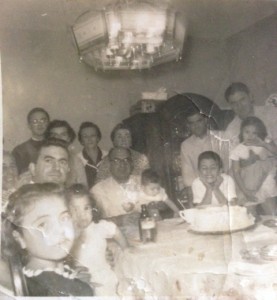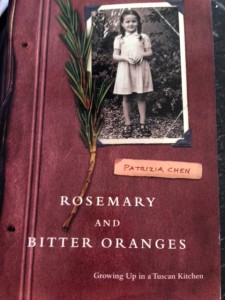When I was a kid, I found the aura of a basement alluring – in certain instances. Ok, is that bizarre to anyone? It’s not to me for, in the Italian-American household of that generation, the basement was often a beehive of activity and in some ways, a place central to the operation of the household. In our house, we had a tiny room which was referred to as the wine cellar. There was no wine in there, just a mish-mash of old dishes that belonged to my Mom. My Dad had a bonafide work bench downstairs – one where he could execute just about anything, ranging from carpentry, electrical work, soldering, plastering, painting, plumbing, masonry and even some forms of experimentation in artwork – such as making copies of tiffany-inspired lampshades, cutting the glass pieces on his own and carefully putting them together – but that’s a story for another day.
When I went to my (paternal) Grandmother’s house, I found the basement to be a curious a place of business – one where she carefully managed the contents, order and activity over the long haul. While I can’t call this a place of outright hoarding, although there was the possibility of this, I’d say it was basically a simple place of storage – of food, wine and uncanny memories, and in some limited cases, a place to cook, on a simple, narrow porcelain-coated 4 burner gas stove – charming. These can only be called memories grown from the ground up.
There is no denying the remnants of the Great Depression and European poverty in the lives of my Grandparents. Their lives seemed to me to be a mixture of grateful appreciation and escape, perhaps only of the momentary kind.
No, I am not talking about 2008 here – and for most of the people I know, there is little, if any, recollection of this time or, of this source of utter enchantment – so moving and apparently, hard-wired that now, some fifty-odd years later, I am working hard to record as many details of this time and those people, as I can. I’m talking about the early 1960s, the time when much of my uber-impressionable, memory-formation took place. For my kids’ generation, the Great Depression and stories, so momentous wave of immigration – the who and why, are the stuff of perhaps one boring US History class, and sadly are now long forgotten. Trips to Ellis Island and stories of old are gone from the landscape just as my Grandparents are. To me, the race is on to try to remember as many details of this time as I possibly can – before they are gone forever. The center of all this activity? “Old” Morristown – where all four of my Grandparents settled and raised their families – and their stories begin as early as the late 19th century. This “place” is long gone and conjures such a continuum of anguish for me that I go out of my way not to go there as much as I can – as I prefer to live with my memories of what it was when I was a kid versus to accept what it has become now. I am working on this but am not doing too well. But, this is another story – one whose subject sometimes rears it’s head in this blog, but I digress.
To say that I am now fascinated with these 4 people is an understatement. This is probably because I can now recognize the importance of their stories, partly, as I try to compare them to the present day immigrants’ experience here in the US. But beyond that, I am fascinated with what they did, what they knew, when they came here, how they were treated and how they began to put a life together in this country in what can now be called, another age. That they were instrumental in creating a warm and meaningful life here is an understatement. Their lives, compared to the way their grandchildren and great-grandchildren live now is, well, like a multi-layered web of energy, talent, personality and urgency like no other. While many in this country now consider immigration akin to some form of pestilence, I find the story of my Grandparents’ generation to be an exciting commentary on the culture of this country, if not the world, something that can only be called rich, but in a very different context of the word. Perhaps this is partly why I am so obsessed with going to Italy – as I find such a sense of comfort and depth there.
Back to Grandma’s Basement. There were many an Italian-American family who had a complete kitchen in their basement – for a wide variety of reasons. Most notably, this was an area for large-scale meal staging, overflow cooking and keeping the mess out of the “real” kitchen. But, what I remember most about this space, and I, for some reason began reminiscing about this two days ago, is the big white cupboard that she had down there – in some ways the center of “operations”. It was a painted piece of furniture that held a variety of pantry items – and for some reason, I can only now recall it containing mostly, canned tomatoes – although I am certain there were lots of other indespensibles. I don’t know why but I found this space fascinating. It would appear that my Grandfather must have engaged in some sort of strange activities in his time because I remember the presence of a slot machine in the basement. We weren’t able to ask questions about this.
There was also an ancient wine press and in some years, he did bottle his own red wine down there. For some reason this occurrence was treated as a big secret – as if he’d be carted off to jail or something if anyone found out. It was this wine that was first introduced to me in the form of wine and peaches – a combination that for years perplexed me completely – until once my own Father allowed me to have a taste. I can remember my surprise as the first unveiling of the complex synergies there and the engaging complexity of the “two fruits” juxtaposed in a glass. One was sweet and luscious, one was tart and almost biting against it. This was all about contrasts, but complementary contrasts, as so much of the creativity-inspired recipe-creation process is. My Dad had some other habits related to food that I, at the time, found confounding. Most notably was the sprinkling of salt upon slices of perfectly ripe Honeydew Melon. Why would you ever sprinkle salt on something sweet? I remember feeling a strong sense of indignance about this – and yet, in hindsight, he understood the salty-sweet attraction of flavors so trendy today. Humph – something he was right about.
Anyway, I remember being sent down into the cool, perfectly clean of that basement, undoubtedly for retrieval purposes, The perfectly clean condition was something that existed partly because that house was new – hand-built by my Grandfather and his two sons, probably mostly by them alone, and partly because my Grandmother was fastidiously clean. I remember being duly impressed about this feat (the building part) mostly because it seemed to be so effortless and purely instinctive to them, and later wondering where all that talent and understanding had gone when it all fell apart. To build a house by oneself was an amazing process of well-webbed industry to me and to this day I am highly impressed with the ability of three people to do such a thing without the direction of a collection of architects and general contractors all over the place. After the house was done there were the inevitable hand-crafted embellishments to be added. Copious numbers of stone walls – one at the road side to hold in the slope of the land, two perfectly skimmed walls framed the driveway, a perfectly laid sidewalk, another wall in the back yard carefully terracing up the slope back there, each and every stone hand-cut. Gardens were carefully carved-in in the form of borders. And, there was the inevitable stone barbecue in the corner, perfectly designed and executed – a place for outdoor cooking, so simple yet so perfect that it makes today’s grilling via a canister of propane seem totally soulless and trite. The tree and shrub selection was carefully made and the Japanese Maple in the front yard perennially a topic of conversation for its solitary majesty. A simple homestead, considered to be a prized possession for its prim and proper execution – a dream of these first and second-generation immigrants – a statement in and of itself. Perfectly skimmed plaster walls is what I remember about this house. Not a knob, tape, seam, dimple nor pimple upon the walls – just perfection – and a skill most difficult to find today. A fireplace in the living room which, to my knowledge was never used and, when the Christmas tree was up – there were those ornaments which the bubbling glass chimneys that were unique and fascinating. It was difficult to get a read on these people. While they lived a simple life, there was an anguish of sorts in the undercurrent. My Grandfather seemed to be cranky most of the time and not a person of much fun. My Grandmother though, was the subject of much fascination for all the skills she had and executed, mostly quietly and seemingly without many needs of her own. That this generation of women never wore a pair of slacks was always fascinating to me. Shorts in the heat of summer, my goodness, no. I hardly ever remember them even exposing their arms. These were still the years, of course, of wearing veils to church.
My Grandmother was a woman of few words and many talents. She knew how to sew perfectly and had a beautiful Singer console sewing machine – electric, in the corner of her dining room. She knew how to crochet and make lace. And the food that came out of her kitchen was to die for. The oldest of, was it 5, or was it more? – Mary Primavera was, to me a gem. (Mary, Dominic, Jimmy, Madeline, Bumpy, and perhaps one or more who had died?) Copious quantities of homemade raviolis came out of that kitchen on Sunday afternoons – enough to be scoffed up by as many as 20 people who gathered around her dining room table. That, of course, was the first course. Then came the Roast. Of course, the kids were all stuffed by then and were allowed usually to leave the table.
I have written of my Grandmother’s talents in the kitchen here before and you can peruse my other stories in the archives. She was undoubtedly a pivotal role model for me. She worked with quiet determination and a sense of perfection in her kitchen, somewhat driven by her own skill and incredible culinary sensibilities but also directed by the incisively-critical commentaries of the men of her generation. Their palates were exacting and refined like no others – whew – it may not have been any fun to cook for these particular people.
That all of this exacting crafting may have been lost on her grandchildren, and is unknown in total to her great-grandchildren, is what has left this indelible collection of memories. What I’d trade to have one day in the kitchen with her today? Perhaps all of my perceived collection of “valuables” – traded for hers.
And, perhaps, one heaping plate of her impeccable, unforgettable Ribbons, Struffoli and Taralli <3<3<3……….. Well, make that 3 heaping platefuls…….
I think this all must stem from the book I am reading, Rosemary and Bitter Oranges – Growing Up in a Tuscan Kitchen by Patrizia Chen.

